Showing Spotlights 209 - 216 of 240 in category All (newest first):
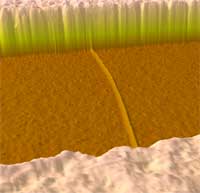 Transistors are the key elements of many types of electronic (bio)sensors. Since the discovery that individual carbon nanotubes (CNTs) can be used as nanoscale transistors, researchers have recognized their outstanding potential for electronic detection of biomolecules in solution, possibly down to single-molecule sensitivity. To detect biologically derived electronic signals, CNTs are often - but not always - functionalized with (conductive) linkers such as proteins and peptides to interface with soluble biologically relevant targets (linkers need not be conductive as long as they are capable of localizing the target molecule in close vicinity of the tube). Although CNT transistors have been used as biosensors for some years now, the ultimate single-molecule sensitivity, which is theoretically possible, has not been reached yet. One of the reasons that hampers the full exploitation of these promising nanosensors is that the sensing mechanism is still not well understood. Although a variety of different sensing mechanisms has been suggested previously, various studies contradict one another, and the sensing mechanism remained under debate. Researchers in The Netherlands - through modeling and specific control experiments - now have succeeded in identifying the sensing mechanism. They found that the majority of their experiments can be explained by a combination of electrostatic gating and Schottky barrier effects. Because these two mechanisms have different gate-potential dependence, the choice of gate potential can strongly affect the outcome of real-time biosensing experiments.
Transistors are the key elements of many types of electronic (bio)sensors. Since the discovery that individual carbon nanotubes (CNTs) can be used as nanoscale transistors, researchers have recognized their outstanding potential for electronic detection of biomolecules in solution, possibly down to single-molecule sensitivity. To detect biologically derived electronic signals, CNTs are often - but not always - functionalized with (conductive) linkers such as proteins and peptides to interface with soluble biologically relevant targets (linkers need not be conductive as long as they are capable of localizing the target molecule in close vicinity of the tube). Although CNT transistors have been used as biosensors for some years now, the ultimate single-molecule sensitivity, which is theoretically possible, has not been reached yet. One of the reasons that hampers the full exploitation of these promising nanosensors is that the sensing mechanism is still not well understood. Although a variety of different sensing mechanisms has been suggested previously, various studies contradict one another, and the sensing mechanism remained under debate. Researchers in The Netherlands - through modeling and specific control experiments - now have succeeded in identifying the sensing mechanism. They found that the majority of their experiments can be explained by a combination of electrostatic gating and Schottky barrier effects. Because these two mechanisms have different gate-potential dependence, the choice of gate potential can strongly affect the outcome of real-time biosensing experiments.
Jan 15th, 2008
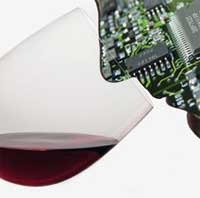 The concept of e-noses - electronic devices which mimic the olfactory systems of mammals and insects - is very intriguing to researchers involved in building better, cheaper and smaller sensor devices. A better understanding of the reception, signal transduction and odor recognition mechanisms for mammals, combined with achievements in material science, microelectronics and computer science has led to significant advances in this area. Nevertheless, the olfactory system of even the simplest insects is so complex that it is still impossible to reproduce it at the current level of technology. For example, the biological receptors are regularly replaced during the life of mammals in a very reliable way so that the receptor array does not require to be recalibrated. The performance of existing artificial electronic nose devices is much more dependent on the sensor's aging and, especially, the sensor's replacement and frequently require a recalibration to account for change. Moreover, current electronic nose devices based on metal oxide semiconductors or conducting polymers that specifically identify gaseous odorants are typically large and expensive and thus not adequate for use in micro- or nano-arrays that could mimic the performance of the natural olfactory system. Nanotechnology is seen as a key in advancing e-nose devices to a level that will match the olfactory systems developed by nature. Nanowire chemiresistors are seen as critical elements in the future miniaturization of e-noses. It is now also believed that single crystal nanowires are most stable sensing elements what will result in extending of life-time of sensors and therefore the recalibration cycle. Last year we reported on a research effort Towards The Nanoscopic Electronic Nose. Scientists involved in this effort now report a second-generation, far more advanced e-nose system based on metal oxide nanowires.
The concept of e-noses - electronic devices which mimic the olfactory systems of mammals and insects - is very intriguing to researchers involved in building better, cheaper and smaller sensor devices. A better understanding of the reception, signal transduction and odor recognition mechanisms for mammals, combined with achievements in material science, microelectronics and computer science has led to significant advances in this area. Nevertheless, the olfactory system of even the simplest insects is so complex that it is still impossible to reproduce it at the current level of technology. For example, the biological receptors are regularly replaced during the life of mammals in a very reliable way so that the receptor array does not require to be recalibrated. The performance of existing artificial electronic nose devices is much more dependent on the sensor's aging and, especially, the sensor's replacement and frequently require a recalibration to account for change. Moreover, current electronic nose devices based on metal oxide semiconductors or conducting polymers that specifically identify gaseous odorants are typically large and expensive and thus not adequate for use in micro- or nano-arrays that could mimic the performance of the natural olfactory system. Nanotechnology is seen as a key in advancing e-nose devices to a level that will match the olfactory systems developed by nature. Nanowire chemiresistors are seen as critical elements in the future miniaturization of e-noses. It is now also believed that single crystal nanowires are most stable sensing elements what will result in extending of life-time of sensors and therefore the recalibration cycle. Last year we reported on a research effort Towards The Nanoscopic Electronic Nose. Scientists involved in this effort now report a second-generation, far more advanced e-nose system based on metal oxide nanowires.
Nov 16th, 2007
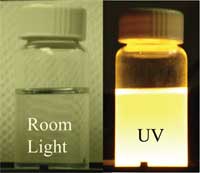 Nanotechnologies opened a new door towards the development of novel techniques and devices for probing biological systems such as biomolecules and single cells. The most reliable bioprobes today rely on fluorescent or radioactive labeling. Phosphorescent emitters are preferable for use in sensing or biological labeling schemes because the emission occurs over a very long timescale (for nanoscientists, 'very long timescale' is a relative term; here we are talking about 1 microsecond). Especially semiconductor nanocrystals (quantum dots) possess several properties that make them very attractive for fluorescent tagging: broad excitation spectrum, narrow emission spectrum, precise tunability of their emission peak, longer fluorescence lifetime than organic fluorophores and negligible photobleaching. Scientists have discovered that these nanocrystals can enable researchers to study cell processes at the level of a single molecule and may significantly improve the diagnosis and treatment of diseases such as cancers. However, the band gap of most emissive semiconductors, with the exception of cadmium-containing materials, is either too high or too low to easily make visible emitting quantum dots. Unfortunately, cadmium is quite toxic and therefore not really suitable for medical applications. In a step towards circumventing the issues with cadmium toxicity, researchers have make progress in demonstrating visible phosphorescence from doped nanocrystal systems. A recent example is the synthesis of a nanoscopic material composed of the non-toxic elements zinc, selenium, sulfur and manganese which displays efficient visible emission.
Nanotechnologies opened a new door towards the development of novel techniques and devices for probing biological systems such as biomolecules and single cells. The most reliable bioprobes today rely on fluorescent or radioactive labeling. Phosphorescent emitters are preferable for use in sensing or biological labeling schemes because the emission occurs over a very long timescale (for nanoscientists, 'very long timescale' is a relative term; here we are talking about 1 microsecond). Especially semiconductor nanocrystals (quantum dots) possess several properties that make them very attractive for fluorescent tagging: broad excitation spectrum, narrow emission spectrum, precise tunability of their emission peak, longer fluorescence lifetime than organic fluorophores and negligible photobleaching. Scientists have discovered that these nanocrystals can enable researchers to study cell processes at the level of a single molecule and may significantly improve the diagnosis and treatment of diseases such as cancers. However, the band gap of most emissive semiconductors, with the exception of cadmium-containing materials, is either too high or too low to easily make visible emitting quantum dots. Unfortunately, cadmium is quite toxic and therefore not really suitable for medical applications. In a step towards circumventing the issues with cadmium toxicity, researchers have make progress in demonstrating visible phosphorescence from doped nanocrystal systems. A recent example is the synthesis of a nanoscopic material composed of the non-toxic elements zinc, selenium, sulfur and manganese which displays efficient visible emission.
Nov 2nd, 2007
 Every few months you can read about a recall of food items, be it fresh spinach of bottled infant formula, due to contamination with salmonella, E. coli or some other foodborne pathogen. A pathogen is a an organism that causes disease in another organism. The Centers for Disease Control and Prevention (CDC) estimates that foodborne diseases cause 76 million illnesses, 325,000 hospitalizations, and 5,000 deaths each year. In 2000, the U.S. Department of Agriculture (USDA) estimated the costs associated with five major bacterial foodborne pathogens to be $6.9 billion. The Food and Drug Administration's 2005 Food Code states that the estimated cost of foodborne illness is $10-$83 billion annually. These staggering numbers, not to mention the potential of foodborne pathogens for terrorists attacks, are driving the development of biosensors as important analytical tools for the rapid detection of pathogens in the field, and they are increasingly playing a key role in controlling disease outbreaks. Immunosensors (biosensors that use antibodies as biological recognition elements) are of great interest because of their applicability (any compound can be analyzed as long as specific antibodies are available) and high sensitivity. High sensitivity, of course, is an important attribute in designing biosensors, but a large variance due to stochastic interaction between biomolecules, biosensor imperfections, and environmental variability (e.g., pH of the analyte) directly affects the reliability of the measured signal in almost all sensors. Researchers have now taken forward error-correction (FEC) techniques, already successfully applied for improving reliability of communication and storage systems such as CDs, and applied them to biosensors.
Every few months you can read about a recall of food items, be it fresh spinach of bottled infant formula, due to contamination with salmonella, E. coli or some other foodborne pathogen. A pathogen is a an organism that causes disease in another organism. The Centers for Disease Control and Prevention (CDC) estimates that foodborne diseases cause 76 million illnesses, 325,000 hospitalizations, and 5,000 deaths each year. In 2000, the U.S. Department of Agriculture (USDA) estimated the costs associated with five major bacterial foodborne pathogens to be $6.9 billion. The Food and Drug Administration's 2005 Food Code states that the estimated cost of foodborne illness is $10-$83 billion annually. These staggering numbers, not to mention the potential of foodborne pathogens for terrorists attacks, are driving the development of biosensors as important analytical tools for the rapid detection of pathogens in the field, and they are increasingly playing a key role in controlling disease outbreaks. Immunosensors (biosensors that use antibodies as biological recognition elements) are of great interest because of their applicability (any compound can be analyzed as long as specific antibodies are available) and high sensitivity. High sensitivity, of course, is an important attribute in designing biosensors, but a large variance due to stochastic interaction between biomolecules, biosensor imperfections, and environmental variability (e.g., pH of the analyte) directly affects the reliability of the measured signal in almost all sensors. Researchers have now taken forward error-correction (FEC) techniques, already successfully applied for improving reliability of communication and storage systems such as CDs, and applied them to biosensors.
Sep 28th, 2007
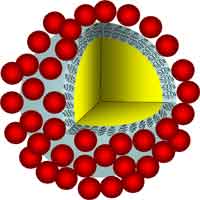 One of the problems nanoscientists encounter in their forays into the nanoworld is the issue of accurate temperature measurement. Ever since Galileo Galilei invented a rudimentary water thermometer in 1593, accurate temperature measurement has been a challenging research topic and thermosensing technologies have become a field in their own right. Now, that technology has reached the nanoscale, temperature gradients are becoming essential in areas such as thermoelectricity, nanofluidics, design of computer chips, or hyperthermal treatment of cancer. Currently there is no established method how to measure the temperature gradients at the nanoscale. Most of today's probes are traditional bulk probes, the kind that gets inserted into a sample and measures the temperature. Liquid crystal films which change colors depending on temperature also have at least microscale thickness and lateral dimensions. A recent review addresses these issues and gives an overview of current and future developments for nanoscale temperature measurement technologies.
One of the problems nanoscientists encounter in their forays into the nanoworld is the issue of accurate temperature measurement. Ever since Galileo Galilei invented a rudimentary water thermometer in 1593, accurate temperature measurement has been a challenging research topic and thermosensing technologies have become a field in their own right. Now, that technology has reached the nanoscale, temperature gradients are becoming essential in areas such as thermoelectricity, nanofluidics, design of computer chips, or hyperthermal treatment of cancer. Currently there is no established method how to measure the temperature gradients at the nanoscale. Most of today's probes are traditional bulk probes, the kind that gets inserted into a sample and measures the temperature. Liquid crystal films which change colors depending on temperature also have at least microscale thickness and lateral dimensions. A recent review addresses these issues and gives an overview of current and future developments for nanoscale temperature measurement technologies.
Jun 1st, 2007
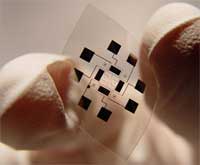 The fabrication of electronic devices on plastic substrates has attracted considerable recent attention owing to the proliferation of handheld, portable consumer electronics. Plastic substrates possess many attractive properties including biocompatibility, flexibility, light weight, shock resistance, softness and transparency. Achieving high performance electronics or sensors on plastic substrates is difficult, because plastics melt at temperatures above 120 degrees C. Central to continued advances in high-performance plastic electronics is the development of robust methods for overcoming this temperature restriction. Unfortunately, high quality semiconductors (such as silicon) require high growth temperatures, so their application to flexible plastics is prohibited. A group of researchers at the California Institute of Technology now showed that highly ordered films of silicon nanowires can be literally glued onto pieces of plastic to make flexible sensors with state-of-the-art sensitivity to a range of toxic chemicals. These nanowires are crystalline wires made out of doped silicon - the mainstay of the computer industry. By etching nanowires into a wafer of silicon, and then peeling them off and transferring them to plastic, they developed a general, parallel, and scalable strategy for achieving high performance electronics on low cost plastic substrates.
The fabrication of electronic devices on plastic substrates has attracted considerable recent attention owing to the proliferation of handheld, portable consumer electronics. Plastic substrates possess many attractive properties including biocompatibility, flexibility, light weight, shock resistance, softness and transparency. Achieving high performance electronics or sensors on plastic substrates is difficult, because plastics melt at temperatures above 120 degrees C. Central to continued advances in high-performance plastic electronics is the development of robust methods for overcoming this temperature restriction. Unfortunately, high quality semiconductors (such as silicon) require high growth temperatures, so their application to flexible plastics is prohibited. A group of researchers at the California Institute of Technology now showed that highly ordered films of silicon nanowires can be literally glued onto pieces of plastic to make flexible sensors with state-of-the-art sensitivity to a range of toxic chemicals. These nanowires are crystalline wires made out of doped silicon - the mainstay of the computer industry. By etching nanowires into a wafer of silicon, and then peeling them off and transferring them to plastic, they developed a general, parallel, and scalable strategy for achieving high performance electronics on low cost plastic substrates.
Apr 23rd, 2007
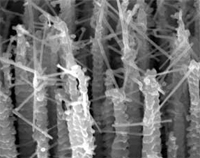 Tremendous progress has been made over the past few years to control the aspects of fabricating simple nanostructures such as wires, tubes, spheres, cubes etc. However, in order to build functional nanodevices, for instance for nanoelectronics or nanobiotechnology, much more complex nanoarchitectures are needed. Initially, the most common, mostly top-down, fabrication methods used for this purpose have been based on nanolithographic techniques. Unfortunately, these methods are burdened with throughput restrictions and high cost and will be of limited use for commercial mass production of nanostructures. To overcome the limitations of nanolithography, a lot of attention has been focused on self-organized bottom-up approaches, which bear good prospects for large-scale fabrication of nanostructures with controlled morphology and dimensionality, and controlled synthesis of arrays. However, the fabrication of complex nanoarchitectures requires sophisticated transfer techniques, which are far from routine, time consuming, and with low reproducibility. To add to the arsenal of scaleable bottom-up fabrication processes, researchers in Germany have developed a method for the batch fabrication of 3D-nanostructures with tunable surface properties. Resembling suspended nanowire webs, these structures have a high potential for catalytic, sensing, or fluidic applications where a high surface to volume ratio is required.
Tremendous progress has been made over the past few years to control the aspects of fabricating simple nanostructures such as wires, tubes, spheres, cubes etc. However, in order to build functional nanodevices, for instance for nanoelectronics or nanobiotechnology, much more complex nanoarchitectures are needed. Initially, the most common, mostly top-down, fabrication methods used for this purpose have been based on nanolithographic techniques. Unfortunately, these methods are burdened with throughput restrictions and high cost and will be of limited use for commercial mass production of nanostructures. To overcome the limitations of nanolithography, a lot of attention has been focused on self-organized bottom-up approaches, which bear good prospects for large-scale fabrication of nanostructures with controlled morphology and dimensionality, and controlled synthesis of arrays. However, the fabrication of complex nanoarchitectures requires sophisticated transfer techniques, which are far from routine, time consuming, and with low reproducibility. To add to the arsenal of scaleable bottom-up fabrication processes, researchers in Germany have developed a method for the batch fabrication of 3D-nanostructures with tunable surface properties. Resembling suspended nanowire webs, these structures have a high potential for catalytic, sensing, or fluidic applications where a high surface to volume ratio is required.
Mar 29th, 2007
 People involved in designing and developing biosensing applications have high hopes that their field can benefit from nanotechnology. The term biosensing relates to systems that include electronic, photonic, biologic, chemical and mechanical means for producing signals that can be used for the identification, monitoring or control of biological phenomena. The resulting biosensors are devices that employ biological components such as proteins to provide selectivity and/or amplification for the detection of biochemical materials for use in medical diagnostics, environmental analysis or chemical and biological warfare agent detection. Applying nanotechnology to biosensors opens up novel detection possibilities thanks to the nano-physical properties of certain materials. A lot of research worldwide is devoted to developing nanobiosensors. A group in Switzerland, for example, is working on the development of two different kinds of label-free biosensors. One is a nanowire array, the other an optical biosensor based on localized surface plasmon resonance.
People involved in designing and developing biosensing applications have high hopes that their field can benefit from nanotechnology. The term biosensing relates to systems that include electronic, photonic, biologic, chemical and mechanical means for producing signals that can be used for the identification, monitoring or control of biological phenomena. The resulting biosensors are devices that employ biological components such as proteins to provide selectivity and/or amplification for the detection of biochemical materials for use in medical diagnostics, environmental analysis or chemical and biological warfare agent detection. Applying nanotechnology to biosensors opens up novel detection possibilities thanks to the nano-physical properties of certain materials. A lot of research worldwide is devoted to developing nanobiosensors. A group in Switzerland, for example, is working on the development of two different kinds of label-free biosensors. One is a nanowire array, the other an optical biosensor based on localized surface plasmon resonance.
Mar 28th, 2007
 Transistors are the key elements of many types of electronic (bio)sensors. Since the discovery that individual carbon nanotubes (CNTs) can be used as nanoscale transistors, researchers have recognized their outstanding potential for electronic detection of biomolecules in solution, possibly down to single-molecule sensitivity. To detect biologically derived electronic signals, CNTs are often - but not always - functionalized with (conductive) linkers such as proteins and peptides to interface with soluble biologically relevant targets (linkers need not be conductive as long as they are capable of localizing the target molecule in close vicinity of the tube). Although CNT transistors have been used as biosensors for some years now, the ultimate single-molecule sensitivity, which is theoretically possible, has not been reached yet. One of the reasons that hampers the full exploitation of these promising nanosensors is that the sensing mechanism is still not well understood. Although a variety of different sensing mechanisms has been suggested previously, various studies contradict one another, and the sensing mechanism remained under debate. Researchers in The Netherlands - through modeling and specific control experiments - now have succeeded in identifying the sensing mechanism. They found that the majority of their experiments can be explained by a combination of electrostatic gating and Schottky barrier effects. Because these two mechanisms have different gate-potential dependence, the choice of gate potential can strongly affect the outcome of real-time biosensing experiments.
Transistors are the key elements of many types of electronic (bio)sensors. Since the discovery that individual carbon nanotubes (CNTs) can be used as nanoscale transistors, researchers have recognized their outstanding potential for electronic detection of biomolecules in solution, possibly down to single-molecule sensitivity. To detect biologically derived electronic signals, CNTs are often - but not always - functionalized with (conductive) linkers such as proteins and peptides to interface with soluble biologically relevant targets (linkers need not be conductive as long as they are capable of localizing the target molecule in close vicinity of the tube). Although CNT transistors have been used as biosensors for some years now, the ultimate single-molecule sensitivity, which is theoretically possible, has not been reached yet. One of the reasons that hampers the full exploitation of these promising nanosensors is that the sensing mechanism is still not well understood. Although a variety of different sensing mechanisms has been suggested previously, various studies contradict one another, and the sensing mechanism remained under debate. Researchers in The Netherlands - through modeling and specific control experiments - now have succeeded in identifying the sensing mechanism. They found that the majority of their experiments can be explained by a combination of electrostatic gating and Schottky barrier effects. Because these two mechanisms have different gate-potential dependence, the choice of gate potential can strongly affect the outcome of real-time biosensing experiments.
 Subscribe to our Nanotechnology Spotlight feed
Subscribe to our Nanotechnology Spotlight feed





